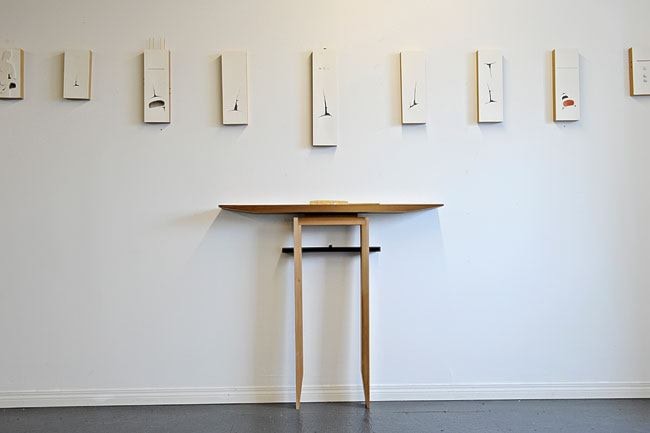‘This is a nude,” says local artist Mark Preston, pointing a piece in his new exhibit at Gallery 22.
It was three-quarters purple on the bottom and one-quarter white along the top. In the centre of the purple, a small white piece of paper was sewn. A slightly slanted “Y” shape, called a split, had been cut from it.
Along the other wall was another piece, mainly black.
The Post-It-sized piece of paper stitched in the centre of this work had ovoids carved out. Throughout the black were vertical lines of buttons, sewn on like falling raindrops.
They are actually lights, said Preston.
“That’s a cityscape - that’s an urban Indian,” he said, laughing.
Preston works in West Coast/Tlingit art, but it’s not traditional. It’s abstract.
Feeling that he has mastered the rules, Preston has begun to break them, he said.
He does this, largely, by removing details.
The five main shapes of West Coast/Tlingit art - the ovoid, split, “U” shape, “S” shape and split “U”- have all been reduced to two or three elegant strokes of his carving knife.
The West Coast/Tlingit style has stood the test of time but while interpretation can vary, the stories largely remain the same, said Preston.
“Even though this art form is magnificent and I enjoy doing it, it’s a story artists keep telling over and over again. I’m trying to reveal a story that hasn’t been told in thousands of years,” he said of his minimalist esthetic featuring subtle hints of the traditional style. “So I’m making it up as I go along.”
Preston’s new story really took off with his paper panels, which feature sleek slits on white paper that only give inklings of the traditional style.
Some can resemble the orca, but there is more than enough space left to interpretation on the bone-white selection.
“It is actually a tree,” said Preston, smiling.
But the focus of the new exhibit is not on the graceful cuts, it’s on the buttons.
Preston takes the idea of the traditional Tlingit button blanket and applies it to all of his work - from jewelry to canvasses to house posts.
The button blanket is similar to the western tradition of a coat of arms, crest or even a tartan. With thinner strips bordering the top and bottom, and thicker strips on either side, the inside holds the clan or family emblem - usually an animal like the killer whale, wolf, eagle, split-tail beaver or frog.
The border strips and, usually, the centred emblem are outlined with the traditional West Coast, fish-scale button. At ceremonies and special events, family members drape the blankets across their shoulders and back as they dance or pray or even just stand, wearing it like a cloak of sorts.
The button blanket represents who you are and where you are from, Preston explained, pointing out the similarities between almost indistinct aspects of his work and the traditional Tlingit vest he carried in his hands.
“Once you get it, it all makes sense,” he said. “It’s almost too simple.”
His work is definitely clean and uncomplicated.
The borders of a button blanket are hinted at with small strips, or perhaps a row of three buttons, sewn on to the canvass or paper.
The centre - the space that represents who you are and where you are from - is where Preston starts taking his less-traditional luxuries.
Some have treetops, others feature colourful ovoid-shaped lily pads, others still are just colours.
The point to remember is that Preston’s new take on the tradition needs more space.
The Yukon artist’s ideas are bigger than the territory’s audience and studio space allows, he said.
The entire exhibit is a scaled-down version of what he would really like to do.
For example, the four to five-inch high wood pieces, displayed on the gallery’s windowsill aren’t just scaled house posts, he said, they are high rises.
And a series of three, abstract button blankets featuring just colours don’t have the same effect on their paper-sized scale. They are supposed to be the size of an entire wall, he said.
“So the colour itself overwhelms you,” he explained.
Preston will be embarking on his second trip to Germany this summer, he said.
It’s a place where “they get it.”
And they are more susceptible to the size of audience and space Preston needs to fulfil his ideas, he said.
“They are so fascinated with First Nation culture and art,” the half Irish, half Tlingit Yukoner said. “Sadly, here in the North, I have to keep illustrating rather then start creating.”
But even with the space he has, Preston’s work takes old ideas, and makes them new.
“I’m assuming my audience knows the history,” he said. “So I only need to give them little hints to tell an entire story.”
Or, for people to interpret their own story, Preston added.
This is the last week to see Preston’s exhibit, Simplicity. It runs until May 28 at Gallery 22 (above Triple J’s music store).
Contact Roxanne Stasyszyn at
roxannes@yukon-news.com
